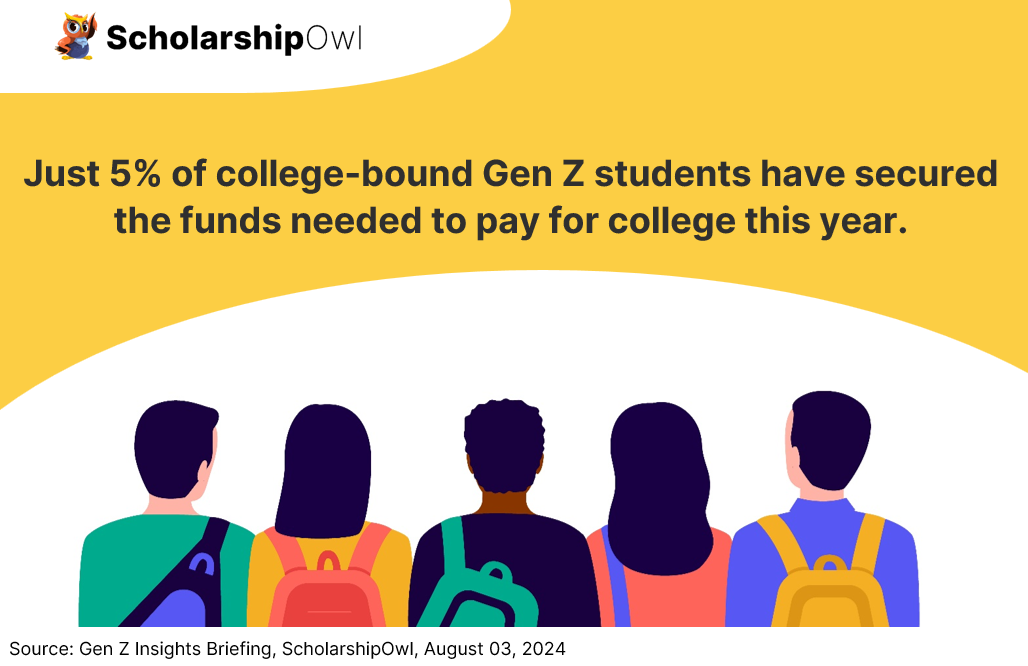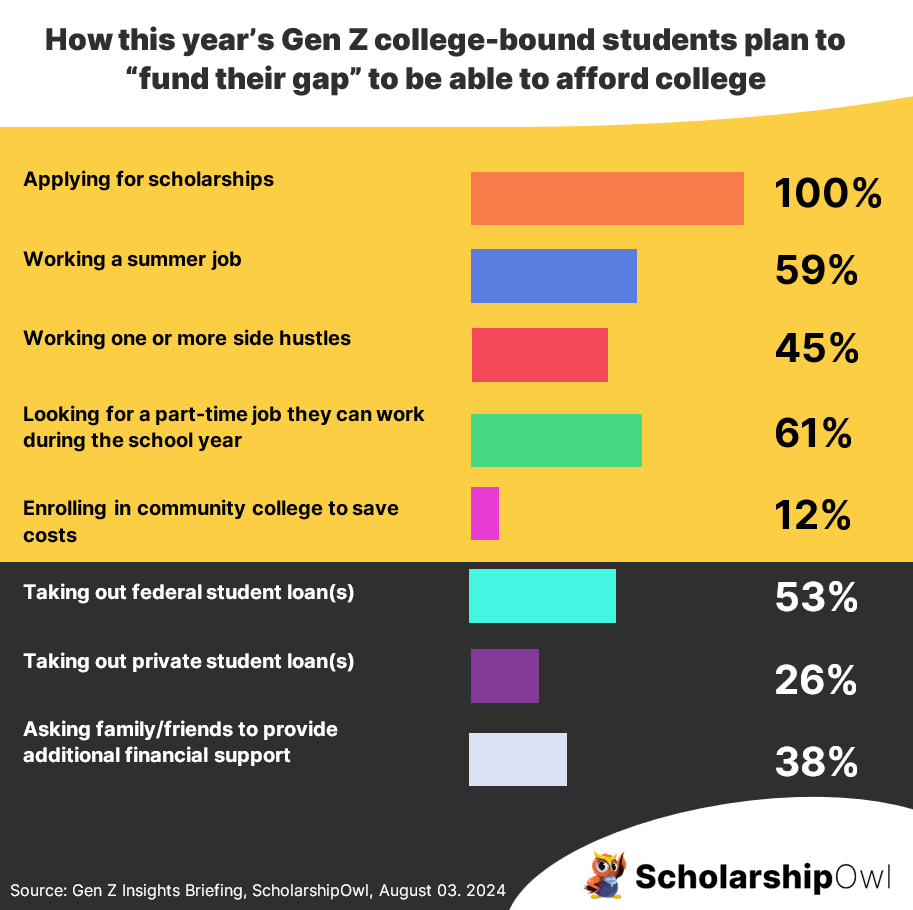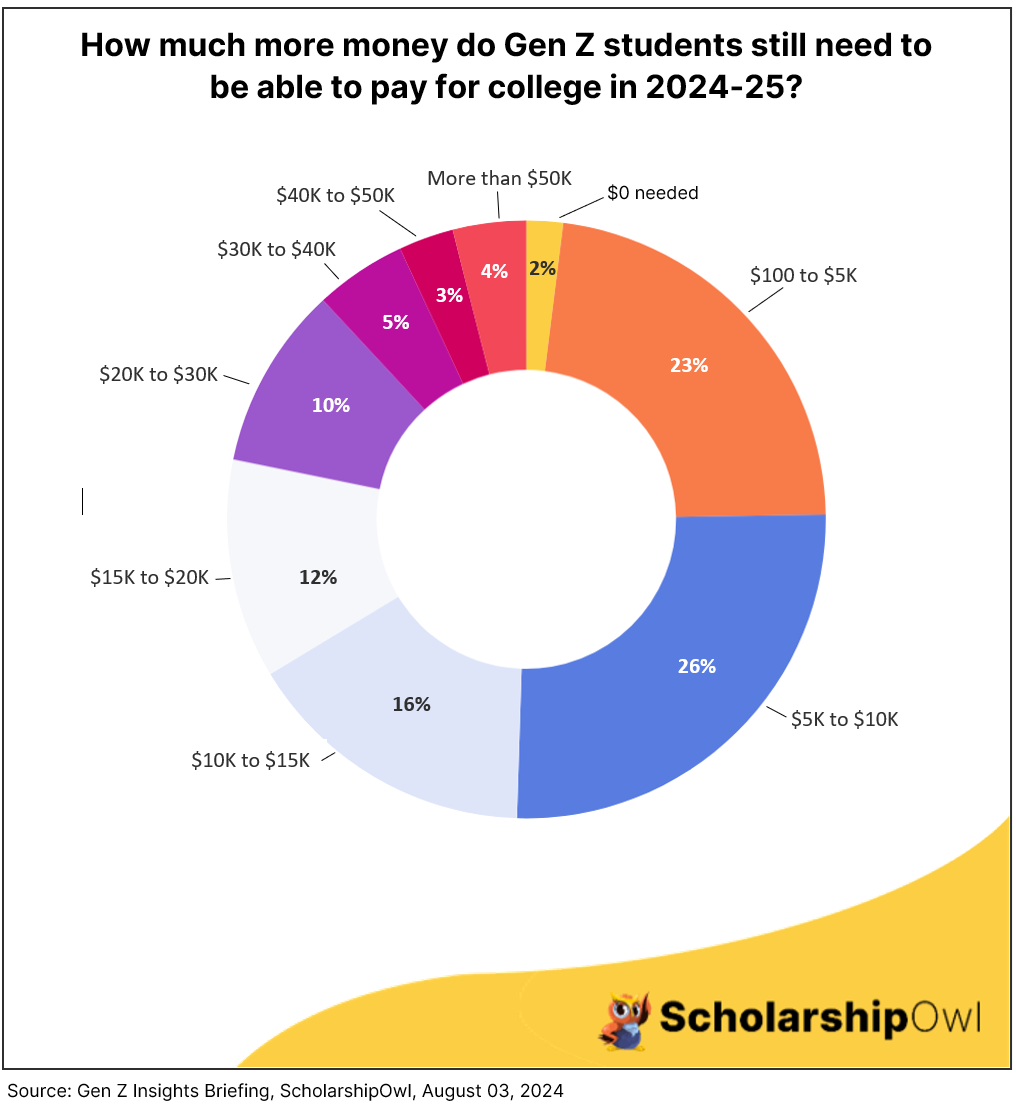In July 2024, ScholarshipOwl continued our on-going deep dive into learning if this year’s college-bound Gen Z have the funds needed to pay for college in the 2024-25 school year. Despite the fact that the Fall tuition bill will be due in August for most college students, we found that just 5% of students have secured the funds necessary to pay for college this year. This news is very disappointing, yet also unsurprising, due to the continually rising cost of college, as well as on-going inflation woes. In fact, the Education Data Initiative reports that over the past twenty years, the cost of college tuition and fees at public universities has risen 179%.

Win more scholarships with less effort
Simplify and focus your application process with the one-stop platform for vetted scholarships.
Check for scholarshipsOur survey also demonstrates that even MORE students are struggling to afford college compared to last month’s survey, that found that only 10% of students have the funds needed to pay for college this year.
Yet there is positive news arising from our survey as well – we can see that Gen Z is resilient and clever, as most of our respondents have developed a multi-pronged strategy for raising the funds needed to attend college this year.
Who participated in the survey?
In July 2024, ScholarshipOwl surveyed high school and college students on the ScholarshipOwl scholarship platform to learn more about their financial preparedness for college. A total of 13,345 students responded.
Among the respondents, 64% were female, 35% were male, and 1% identified themselves as a different gender identity or preferred not to respond to the question. Nearly half (42%) were Caucasian, 29% were Black, 17% were Hispanic/Latino, 6% were Asian/Pacific Islander, 2% were American Indian/Native American and 5% selected “other” or preferred not to respond to the question.
Over one-quarter (27%) of the respondents were high school students, with the vast majority high school seniors; nearly two-thirds (60%) were college undergraduate students, primarily college freshmen and college sophomores; 9% were graduate students and 4% identified themselves as adult/non-traditional students.
Survey topics
Availability of the funds Gen Z students need for college
We began the survey by asking a qualifying question, so that we could ensure that most of the respondents were planning to attend college in the coming school year. We asked students, “Will you be attending college in 2024-25?”
- 88% said yes
- 12% said no
We then asked, “Do you have enough money to cover college costs for the 2024-25 school year? Among the students who are planning to attend college in 2024-25, just 5% reported that they had secured the funds needed to pay for college in the coming school year, while the overwhelming majority (95%) indicated that they had not.

How Gen Z students are planning to “fund their gap” to be able to afford college this year
Our next question was, “If you don’t currently have enough money to cover college costs for 2024-25, which of the following are you doing to make up the difference? Select all that apply.”
Among the students who will attend college in 2024-25, the vast majority selected more than one answer, indicating that they are taking a multi-pronged approach to secure the additional funds needed.
Some of these approaches are more positive:
- 100% are applying for scholarships
- 59% are working at a summer job
- 45% are working one or more side hustles (food delivery driver, rideshare driver, dog-walker, babysitter, handyperson, freelance work, getting paid as an influencer, etc.)
- 61% are looking for a part-time job they can work during the school year
- 12% will be enrolling in community college rather than a 4-year university to save costs
While other approaches will have long-term adverse financial impact on themselves and their families:
- 53% are taking out federal student loans
- 26% are taking out private student loans
- 38% are asking family or friends to provide additional financial support

How much more money Gen Z students need to be able to pay for college this year
Our final question was, “If you will be enrolled in college in 2024-25, approximately how much money do you still need to come up with to be able to pay for college this year?”
Among the students who will attend college in 2024-25:
- Just 2% said they already have enough funds
- 23% need $100 to $5,000
- 26% need $5,000 to $10,000
- 16% need $10,000 to $15,000
- 12% need $15,000 to $20,000
- 10% need $20,000 to $30,000
- 5% need $20,000 to $40,000
- 3% need $40,000 to $50,000
- 4% need more than $50,000

Key takeaways
The results of this survey continue to stun. Just 5% of respondents have secured the funds needed to pay for college in 2024-25, despite the fact that school begins in August for most students. While most students indicated that they are applying multiple approaches to obtain the funds needed, the majority included taking out federal and/or private student loans as part of their solution. Their families will also be impacted, as more than one-third (38%) are expecting that their family/friends will provide additional financial support to help them achieve their dream of going to college.
Despite this unfortunate news, students continue to persevere and are taking positive steps to accumulate the funds needed, which will help them reduce their reliance on student loans and support from family and friends:
- All respondents are using their own income to help pay for college – this includes students who are working this summer and/or who plan to work while they are in school.
- All respondents are actively applying for scholarships to earn money for college.
How can Gen Z students ensure they can afford college in 2024-25 and beyond?
There are a number of steps that students can take to ensure they have an affordable path to college:
- Prioritize applying for scholarships with ScholarshipOwl. Apply for scholarships all summer long, and throughout the school year.
- Work part-time during the school year and full-time during breaks. Save your earnings to use for your college education.
- Submit the FAFSA every year for every year that you’ll be in college, beginning in your senior year of high school, and continuing to submit it annually until you complete your college education. The FAFSA opens on October 1st each year.
- When you receive your financial aid offers, compare them and focus on choosing the most affordable college. If your first-choice school offered you a less financial aid and scholarships than other schools offered, contact your preferred school to see if you can negotiate your offer to one that is more affordable for you.
- Always consider starting at a community college, which offers a truly affordable option – and don’t forget that community colleges also offer federal and state grant aid, and they also offer scholarships. So even if you are planning to attend community college, always submit your FAFSA and always apply for scholarships!
REMEMBER: Student loans should always be a last-resort option for paying for college. Focus on debt-free sources that will enable you to graduate without the burden of owing thousands of dollars for college! Focus on applying for scholarships and jobs, NOT loans, so that you can graduate debt-free. There IS an affordable path to college – for further information, and to start applying for scholarships, visit www.scholarshipowl.com.



